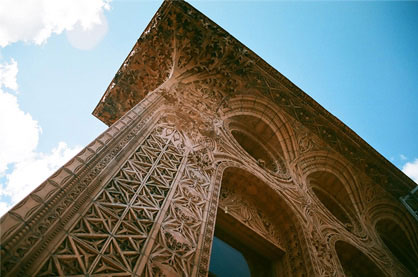Louis Sullivan: The Struggle for American Architecture
by George Sax

The Structure of Genius
Whenever Buffalo’s architectural heritage comes up for discussion, Frank Lloyd Wright and his several residential commissions in and around the city usually dominate the topic. Wright is the superstar of American architectural history, in some measure because of both his career longevity and his gift for self-promotion, and perhaps the deceptively harmonious-seeming appearance of the many residences he designed across the country.
But there’s an architectural masterwork in downtown Buffalo with a claim on historical importance that transcends that of Wright’s local work. (His one commercial commission, the Larkin Building, is, of course, long gone.) Louis Sullivan’s Guaranty Building is a landmark of a different stripe and greater significance, a “tall building” that was a harbinger of the last century’s proliferating skyscraper construction in the dense, upwardly thrusting urban settings of the US. Sullivan and this building have a place in American history—architectural, economic, and cultural—that Wright’s local work doesn’t.
It’s the story of this significance, and of Sullivan’s groundbreaking but ultimately thwarted career that Mark Richard Smith’s intelligent, sometimes strikingly photographed documentary, Louis Sullivan: The Struggle for American Architecture, seeks to tell. It’s an important cultural story, and, for the most part, Smith tells it very well. He clearly enough presents the frustrated, tragic dimension to Sullivan’s life and career, even if the man remains somewhat elusive as a person. Sullivan seems to have been rather an outsider and a lonely innovator, even in the period of his successes around the turn of the 20th century. But if about all most educated people remember of him now is his famous, barely understood dictum, “Form follows function,” Smith’s film sheds welcome light on the man and his architectural theorem.
Louis Sullivan ably sets the scene for its subject’s heralded but little understood career. Narrator Smith and a complement of architectural historians and critics describe the young Sullivan’s early, vaunting ambition and impatient dissatisfaction with the classically oriented education and design that held sway in the last third of the 19th century. The Massachusetts-born Sullivan chose to make his professional way in Chicago, the big-shouldered, bustling, rapidly expanding commercial center of the American Midwest. He arrived on the cusp of the Gilded Age, as its crude new plutocracy was taking shape. Smith and his commentators make clear that the new economic and social conditions at first facilitated and then damaged his prospects.
The film follows Sullivan’s life as he drew laudatory attention for his work on his and Dagmar Adler’s awe-inspiring and innovative Auditorium Theatre in Chicago (promoted by the city’s commercial elite to buy some respectability after the Haymarket Square bombing and the execution of several, probably railroaded labor leaders), and then moves on to the design of the Guaranty Building in 1894. Here, Sullivan’s design vividly exemplified his “form” precept, and more eloquently than much of his written theorizing. The building’s terra cotta facing, or “skin,” expresses its framework and its division of space within. The Guaranty also bears the strategically placed and intricate decoration for which Sullivan became professionally renowned. (His one-time and later alienated protégé Wright paid public tribute to it years after they had a bitter break.)
Sullivan’s own discourse on his aesthetics, excerpted for the film’s narration, including the statement that such work as the Guaranty design expressed “the pervading law of all things organic and inorganic,” can have the ad hoc arbitrariness of a lot of architects’ aesthetic pronouncements. (Sullivan’s insistence that art and nature were, in effect, two sides of the same coin probably would have drawn a spirited dissent from his contemporary, Oscar Wilde.)
The sad evolution of Sullivan’s later, blighted life and work are sympathetically and perceptively laid out. First, the panic of 1893, and then the vulgar, ostentatious ethos of the new capitalists, who were uninterested in an architect dedicated to developing a specifically American, republican kind of design, did major damage to Sullivan.
As the Architectural Record editors said just after the First World War, Sullivan was “a prophet, not without honor, save in his own country.”
Louis Sullivan: The Struggle for American Architecture opens on Thursday, November 4, for a one-week engagement at the Screening Room in Amherst.
Watch the trailer for Louis Sullivan: The Struggle for American Architecture
blog comments powered by Disqus
|
Issue Navigation> Issue Index > v9n43 (week of Thursday, October 28) > Louis Sullivan: The Struggle for American Architecture This Week's Issue • Artvoice Daily • Artvoice TV • Events Calendar • Classifieds |









 Current Issue
Current Issue